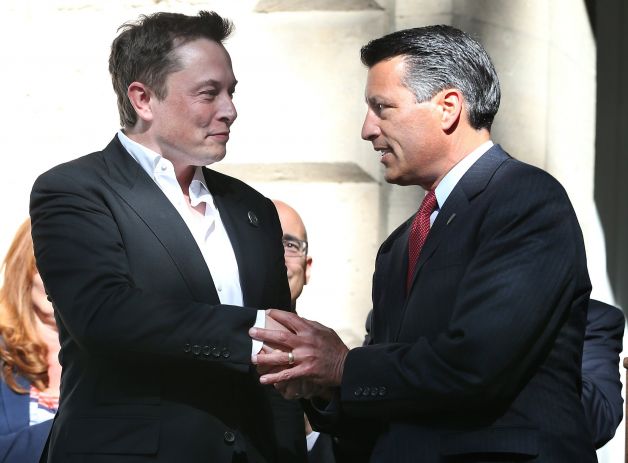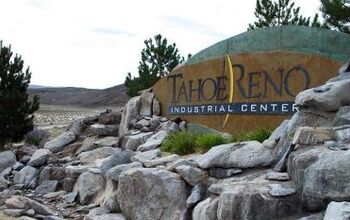Nevada Governor Signs Tesla Tax Package Into Law
A week after the announcement, and through two days of deliberation by the state legislature, Nevada governor Brian Sandoval signed into law September 11 the $1.25 billion tax package that won over Tesla enough to bring its Gigafactory to the Silver State.
Reno Gazette-Journal breaks down the complete package as follows:
- $725 million: 20-year, 100 percent sales tax abatement
- $332 million: 10-year, 100 percent property tax abatement
- $120 million: Transferable tax credits
- $75 million: $12,500/job transferable tax credits (up to 6,000 jobs)
- $27 million: 10-year, 100 percent modified business tax abatement
- $8 million: Discounted electricity rates for eight years
In addition, the state will buy Tahoe Reno Industrial Center’s main road, the USA Parkway, for $43 million, and will extend the road to U.S. Highway 50 at a cost yet to be determined.
Finally, the legislature had to agree to give Tesla and other EV manufacturers the right to directly sell their wares to customers in Nevada without going through the traditional dealership model.
In exchange, Tesla will provide $7.5 million annually to the state for education funding over the next five years beginning in 2018, as well as invest $3.5 billion in manufacturing equipment and real estate in Nevada.
Meanwhile, the insurance and film industries lost on their respective tax incentive programs as funds were siphoned into the Tesla deal. The former loses a $27 million/year credit that had been a mainstay for 40 years; the latter sees a hard-won $80 million/year credit meant for movie production over the next four years reduced to just $10 million/year.
As for economic impact, the state expects $100 billion over the next two decades, ranging from 6,500 employees making $25/hour assembling the battery packs meant for all of Tesla’s vehicles and others interested in them, to a 4 percent increase in the state’s gross domestic product.
Seattle-based writer, blogger, and photographer for many a publication. Born in Louisville. Raised in Kansas. Where I lay my head is home.
More by Cameron Aubernon
Latest Car Reviews
Read moreLatest Product Reviews
Read moreRecent Comments
- Jkross22 Their bet to just buy an existing platform from GM rather than build it from the ground up seems like a smart move. Building an infrastructure for EVs at this point doesn't seem like a wise choice. Perhaps they'll slow walk the development hoping that the tides change over the next 5 years. They'll probably need a longer time horizon than that.
- Lou_BC Hard pass
- TheEndlessEnigma These cars were bought and hooned. This is a bomb waiting to go off in an owner's driveway.
- Kwik_Shift_Pro4X Thankfully I don't have to deal with GDI issues in my Frontier. These cleaners should do well for me if I win.
- Theflyersfan Serious answer time...Honda used to stand for excellence in auto engineering. Their first main claim to fame was the CVCC (we don't need a catalytic converter!) engine and it sent from there. Their suspensions, their VTEC engines, slick manual transmissions, even a stowing minivan seat, all theirs. But I think they've been coasting a bit lately. Yes, the Civic Type-R has a powerful small engine, but the Honda of old would have found a way to get more revs out of it and make it feel like an i-VTEC engine of old instead of any old turbo engine that can be found in a multitude of performance small cars. Their 1.5L turbo-4...well...have they ever figured out the oil dilution problems? Very un-Honda-like. Paint issues that still linger. Cheaper feeling interior trim. All things that fly in the face of what Honda once was. The only thing that they seem to have kept have been the sales staff that treat you with utter contempt for daring to walk into their inner sanctum and wanting a deal on something that isn't a bare-bones CR-V. So Honda, beat the rest of your Japanese and Korean rivals, and plug-in hybridize everything. If you want a relatively (in an engineering way) easy way to get ahead of the curve, raise the CAFE score, and have a major point to advertise, and be able to sell to those who can't plug in easily, sell them on something that will get, for example, 35% better mileage, plug in when you get a chance, and drives like a Honda. Bring back some of the engineering skills that Honda once stood for. And then start introducing a portfolio of EVs once people are more comfortable with the idea of plugging in. People seeing that they can easily use an EV for their daily errands with the gas engine never starting will eventually sell them on a future EV because that range anxiety will be lessened. The all EV leap is still a bridge too far, especially as recent sales numbers have shown. Baby steps. That's how you win people over.


































Comments
Join the conversation
I bet The education "credits" are the people that get sent to seminars or the University of Phoenix for this and tha. Probably spread over 10 or 15 years. Basically, an illusory press release benefit. Just a guess. Another press release feature is the astonishing 20 X multiplier effect of this investment, all in the state of Nevada alone. The highest multipliers I ever heard of are in the 5 X range. It so happens that the cost of the Medicaid expansion of O-Care in Nevada is slightly larger. So does that mean there's going to be 200 billion dollars of extra economic activity in Nevada alone between O-care and Elon Musk? OK it's gummint spending. Let's assume a measly 10X multiplier. 150 billion in new economic activity in Nevada? Remember, this is a state with an annual budget just a little over 5 billion. My point is that these economic projections reported in the newspaper don't pass the laugh test. They are pure, unadulterated bullshit. The gigafactory will supposedly cost Tesla $5 billion, but the first phase is 3 billion. What are the clawbacks if Tesla doesn't come through? You notice there's no mention of that. Remember, if Tesla goes belly up, a distinct possibility, given the riskiness of the venture, it won't even matter if they have clawbacks. P.S. Here's another word for "transferrable tax credits" It's called "cash"
Anyone who knows if the termination of the battery delivery deal with Toyota will affect the plant's prospects and perhaps even Tesla itself?